---
People die in stream crossings. They underestimate the risk. It’s better to turn around than risk a dangerous crossing. Remember, most hikers delay their trips until after peak runoff. That’s the safest option.
How to assess a creek crossing for a safer place to cross.
Look downstream—and consider what happens if you get swept away.
Are there any hazards? Hazards could include waterfalls, boulders, strainers, undercut banks or bends in the river where the current gets fast and deep. If you slip and fall, you’re going for a ride. Even a light current can easily push you far downstream. Make sure there’s nothing nasty downstream that you could get pushed into. Also, make sure that the banks aren’t so steep, brushy, or snowy that you won’t be able to get out.
https://www.pcta.org/discover-the-trail ... ng-safety/
---
One thing that is typically missing in planning/studying is having a ready source of comparative context. Sure, there's plenty of photos of crossings, but rarely discussion/opinion. The PCTA addressed this as well by posting this photo & comment:

To us, this looks like a very fast moving and probably dangerous crossing. Photo by Neil Butler.
IMO, I think the comment is spot on. As someone who is pretty good in water, and has done his share of high-water crossings, this is the very type of situation that can catch people off guard. For one, the stream itself isn't that wide, but the center flow is moving pretty fast. For two, it looks pretty bouldery, so it may be both slippery and be difficult to shuffle. For three, the hiker is heading out solo, so he's acting pretty confident.
For some context, the Taboose crossing last year during the meet-up looked like this - sans the far calm width. IOW, it was all turbulence about as wide as the central portion of this stream. In our case, the Taboose crossing didn't have any options further up/down stream since it was in such a narrow, steep, bushy canyon. OTH, if I was this hiker, I think I would have looked for a flatter, less agitated spot to cross if given the opportunity.
Anyway, the main article has a lot of informative advice & tips, as well as many other photos & commentary.

